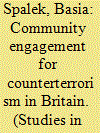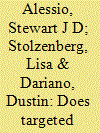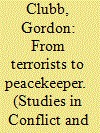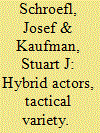|
|
|
Sort Order |
|
|
|
Items / Page
|
|
|
|
|
|
|
| Srl | Item |
| 1 |
ID:
134442


|
|
|
|
|
| Summary/Abstract |
So far there has been little substantive research about how individuals engaged in counterterrorism initiatives, whether as community members or police officers or other professionals, negotiate this challenging terrain. This article suggests that community-based approaches to counterterrorism rely on the careful construction of certain forms of community engagement, rather than an all-encompassing claim that “communities defeat terrorism.” This article explores this issue further through analyzing and exploring the role that connectors, rather than communities per se, may play in counterterrorism.
|
|
|
|
|
|
|
|
|
|
|
|
|
|
|
|
| 2 |
ID:
134445


|
|
|
|
|
| Summary/Abstract |
From January 1979 to December 2009, the Maoist insurgent Shining Path committed a total of 9,034 violent acts in a concerted attempt to topple the Peruvian government. These acts of violence included bombings, armed assaults, and assassinations. The Shining Path's leader Abimael Guzmán was captured by the Peruvian government on 12 September 1992. Using quarterly data and an interrupted times-series AutoRegressive Integrative Moving Average (ARIMA) study design, we investigated the effect of Abimael Guzmán's capture on the ability of the Shining Path to wage its war against the Peruvian government. Maximum-likelihood results revealed that the frequency of terrorist acts committed by the Shining Path dropped by 143 incidents per quarter a short time after Guzmán was captured. The analysis also evinced a positive relationship between the lethality of attacks and the frequency of the Shining Path's terrorist activity. We conclude that targeted capture shows some promise as an effective counterterrorism strategy, at least for terrorist groups such as the Shining Path that have a top-down type of organizational structure.
|
|
|
|
|
|
|
|
|
|
|
|
|
|
|
|
| 3 |
ID:
134443


|
|
|
|
|
| Summary/Abstract |
Utilizing interviews with former Irish Republican Army (IRA) members, Loyalists, and community workers, the article looks at how militants in Northern Ireland have helped to prevent terrorism and political violence (TPV) by adopting roles in the community. By using mobile phones, a network of former combatants emerged around interface areas in the late 1990s to contain trigger causes of terrorism, providing a unique role that the state could not. The structure of the network encouraged militant groups to follow the IRA's example to disengage—thus creating a domino effect—and the co-operation between senior militants has limited the opportunities for other groups to mobilize a campaign of terrorism.
|
|
|
|
|
|
|
|
|
|
|
|
|
|
|
|
| 4 |
ID:
134444


|
|
|
|
|
| Summary/Abstract |
Wars like those in Iraq and Afghanistan should be understood as hybrid wars, wars in which elements of ethnic or tribal conflict, ideologically based insurgency, factional squabbling, and organized crime are inextricably intertwined, with the same actors playing multiple and partially conflicting roles. Hybrid war is inherently transnational, featuring transnational crime networks, “migrant warriors,” transnational diaspora links, legitimate international trade, and foreign intervention. It takes place in hybridized states reliant on local warlords and other actors whose power prevents effective state-building. In this context, while counterinsurgency doctrine prescribes appropriate military strategy and tactics, the core problem is more political than military. Since a hybridized client state is not likely to be politically reformable even if a foreign ally achieves military success, outside allies like the United States should generally refrain from boots-on-the-ground intervention, pursuing instead a diplomatic solution, even though such a deal is likely to be unpalatable.
|
|
|
|
|
|
|
|
|
|
|
|
|
|
|
|
|
|
|
|
|